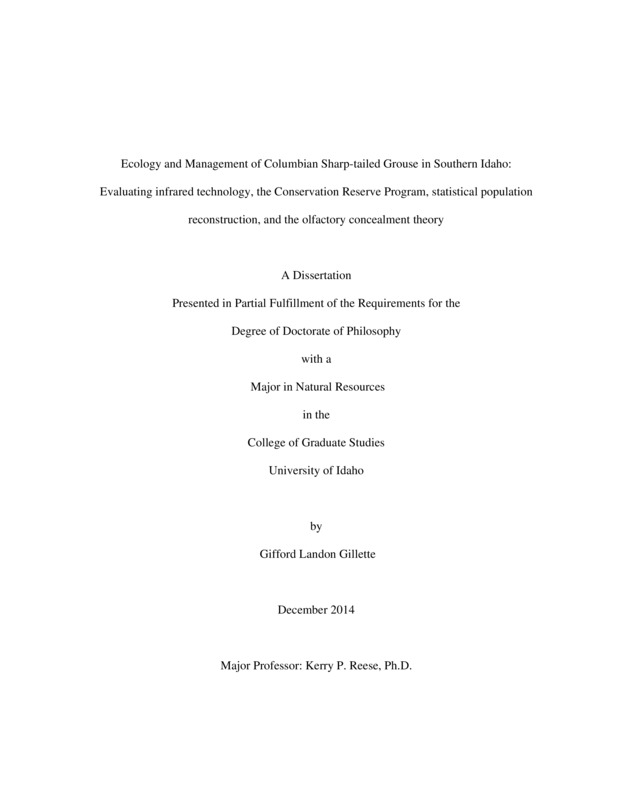Ecology and Management of Columbian sharp-tailed grouse in Southern Idaho: Evaluating infrared technology, the Conservation Reserve Program, statistical population reconstruction, and the olfactory concealment theory
Gillette, Gifford Landon. (2014). Ecology and Management of Columbian sharp-tailed grouse in Southern Idaho: Evaluating infrared technology, the Conservation Reserve Program, statistical population reconstruction, and the olfactory concealment theory. Theses and Dissertations Collection, University of Idaho Library Digital Collections. https://www.lib.uidaho.edu/digital/etd/items/gillette_idaho_0089e_10478.html
- Title:
- Ecology and Management of Columbian sharp-tailed grouse in Southern Idaho: Evaluating infrared technology, the Conservation Reserve Program, statistical population reconstruction, and the olfactory concealment theory
- Author:
- Gillette, Gifford Landon
- Date:
- 2014
- Keywords:
- aerial infrared Conservation Reserve Program demographic rates lek count sharp-tailed grouse statistical population reconstruction
- Program:
- Natural Resources
- Subject Category:
- Wildlife management; Ecology; Wildlife conservation
- Abstract:
-
Wildlife biologists often use counts of individual birds attending leks to monitor several grouse species, but we lack a standard method for counting Columbian sharp-tailed grouse (Tympanuchus phasianellus columbianus; CSTG) on leks. We compared two count methods: aerial infrared (AIR) counts of CSTG on leks and ground-based lek counts. We did not detect a difference in counts between sampling methods on 12 April 2012 because confidence intervals overlapped zero (-0.14 to 2.14). The cost to conduct AIR counts was twice that of ground counts (on a per lek basis), but AIR allowed us to survey more leks in less time. Hence, we believe AIR has potential as a standard lek count method for CSTG.
Abundance estimates for CSTG do not include confidence interval estimation. We used statistical population reconstruction (SPR) to estimate the hunted Idaho population of CSTG during 2000-2013. The estimated abundance for Idaho was stable around 37,000 adults (± 6,400). Thus, harvest rates of 0.05-0.16 appear appropriate for maintaining populations. SPR is a flexible framework for estimating abundance, but is seldom used by wildlife managers. Workshops, software, or guide books are needed to help managers with model development and mechanics of SPR.
Wildlife agencies consider the Conservation Reserve Program (CRP) beneficial to CSTG populations but demographic rates in CRP compared to those in shrub-steppe are unknown. We measured CSTG demographic rates in CRP lands from 2011 to 2013 in Idaho. CSTG successfully bred, nested, and reared young in CRP albeit at comparatively lower rates (λ = 0.77 ± 0.284) than grouse occupying shrub-steppe (λ = 1.08 ± 0.316). CRP aids CSTG conservation in Idaho but population growth in CRP habitats is unlikely.
Nest success is a significant life stage influencing populations of CSTG as predation is the primary source of nest failure. We used videography of CSTG nests to describe nest predators and measured wind characteristics with anemometers at nests to test the olfactory concealment theory. American badgers (Taxidea taxus) and coyotes (Canis latrans) caused 75% of nest failures. Wind characteristics at CSTG nest sites did not support predictions of the olfactory concealment theory.
- Description:
- doctoral, Ph.D., Natural Resources -- University of Idaho - College of Graduate Studies, 2014
- Major Professor:
- Reese, Kerry P
- Committee:
- Connelly, John W; Conway, Courtney J; Bunting, Stephen C
- Defense Date:
- 2014
- Identifier:
- Gillette_idaho_0089E_10478
- Type:
- Text
- Format Original:
- Format:
- application/pdf
- Rights:
- In Copyright - Educational Use Permitted. For more information, please contact University of Idaho Library Special Collections and Archives Department at libspec@uidaho.edu.
- Standardized Rights:
- http://rightsstatements.org/vocab/InC-EDU/1.0/

